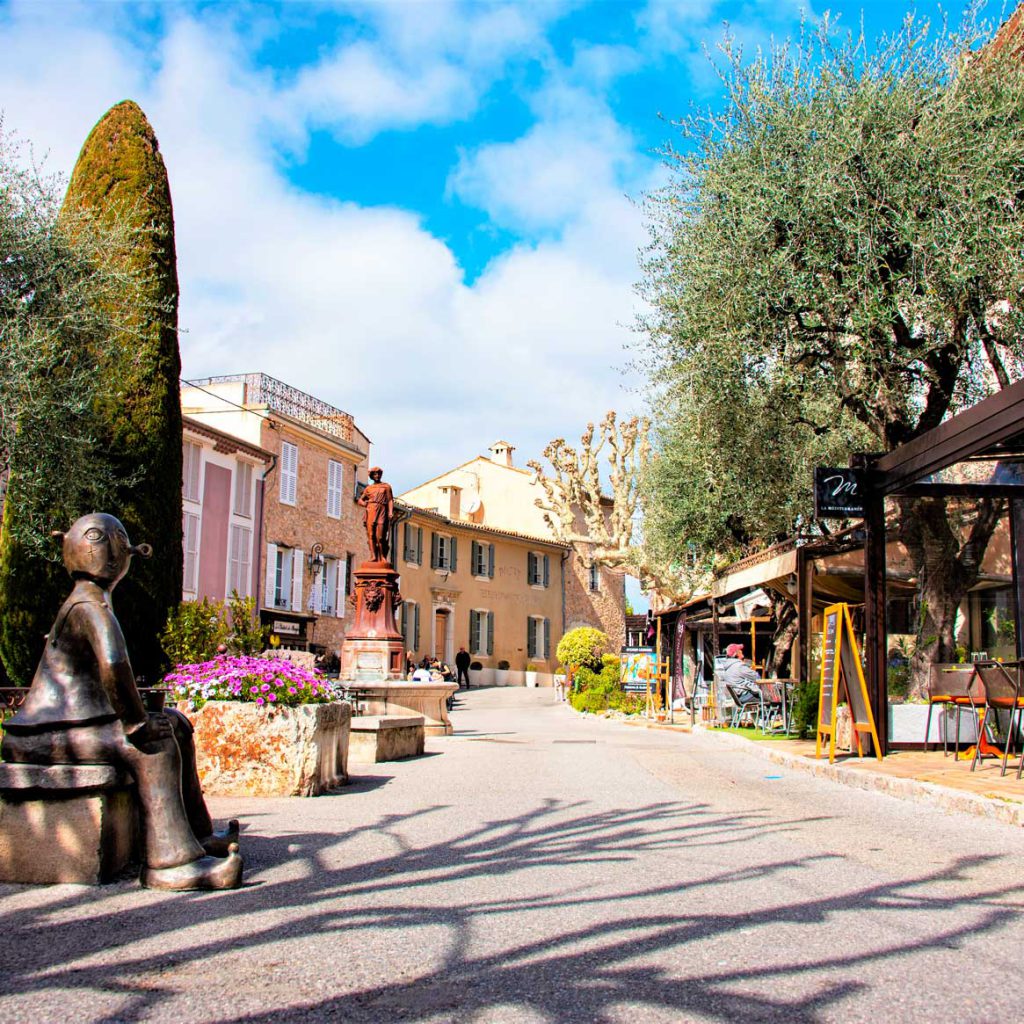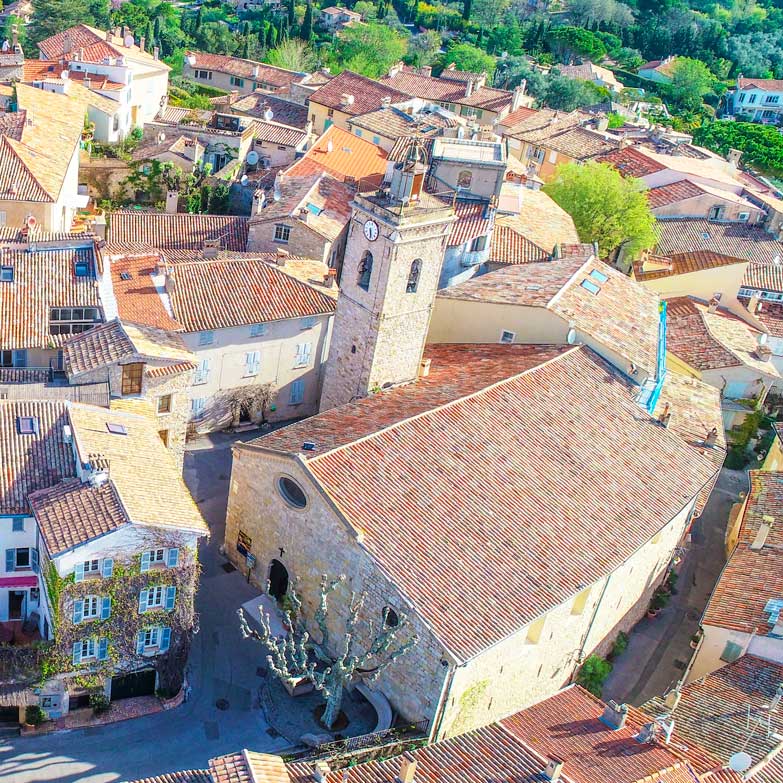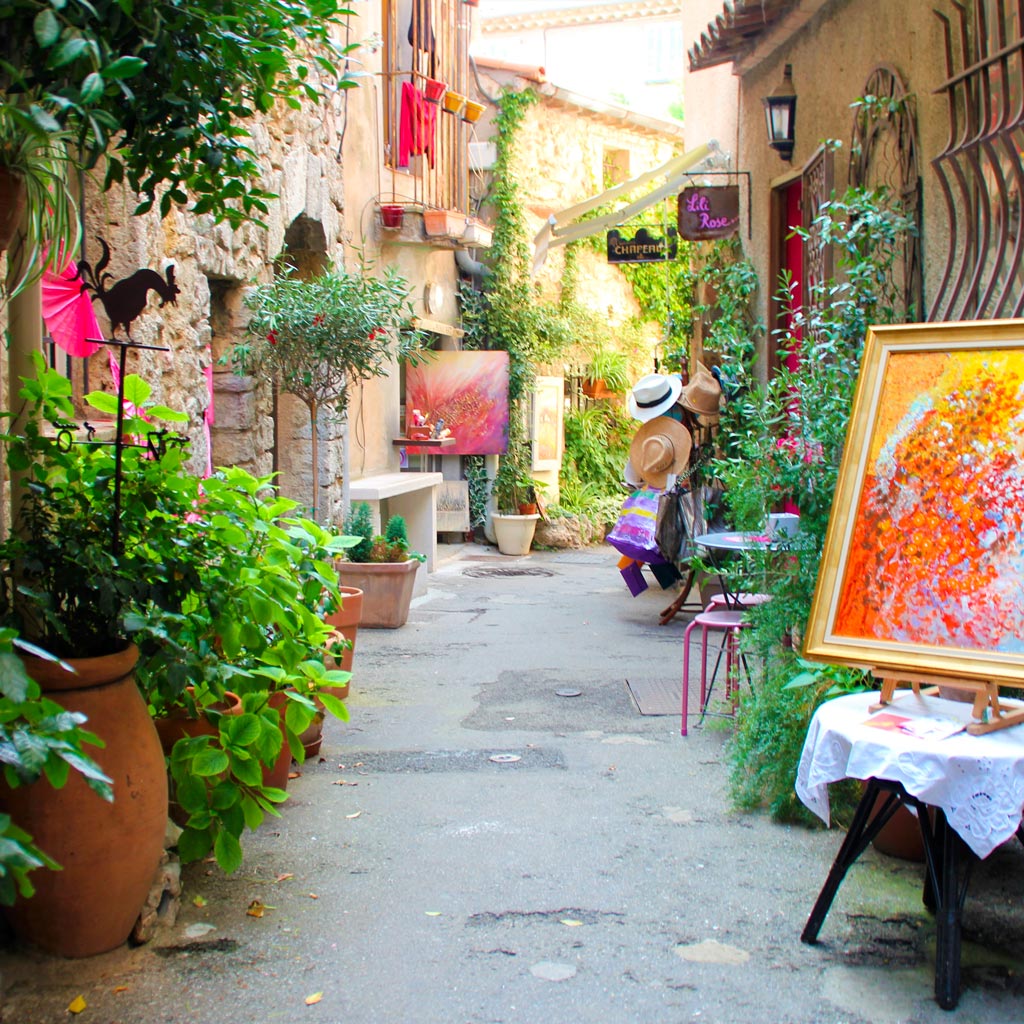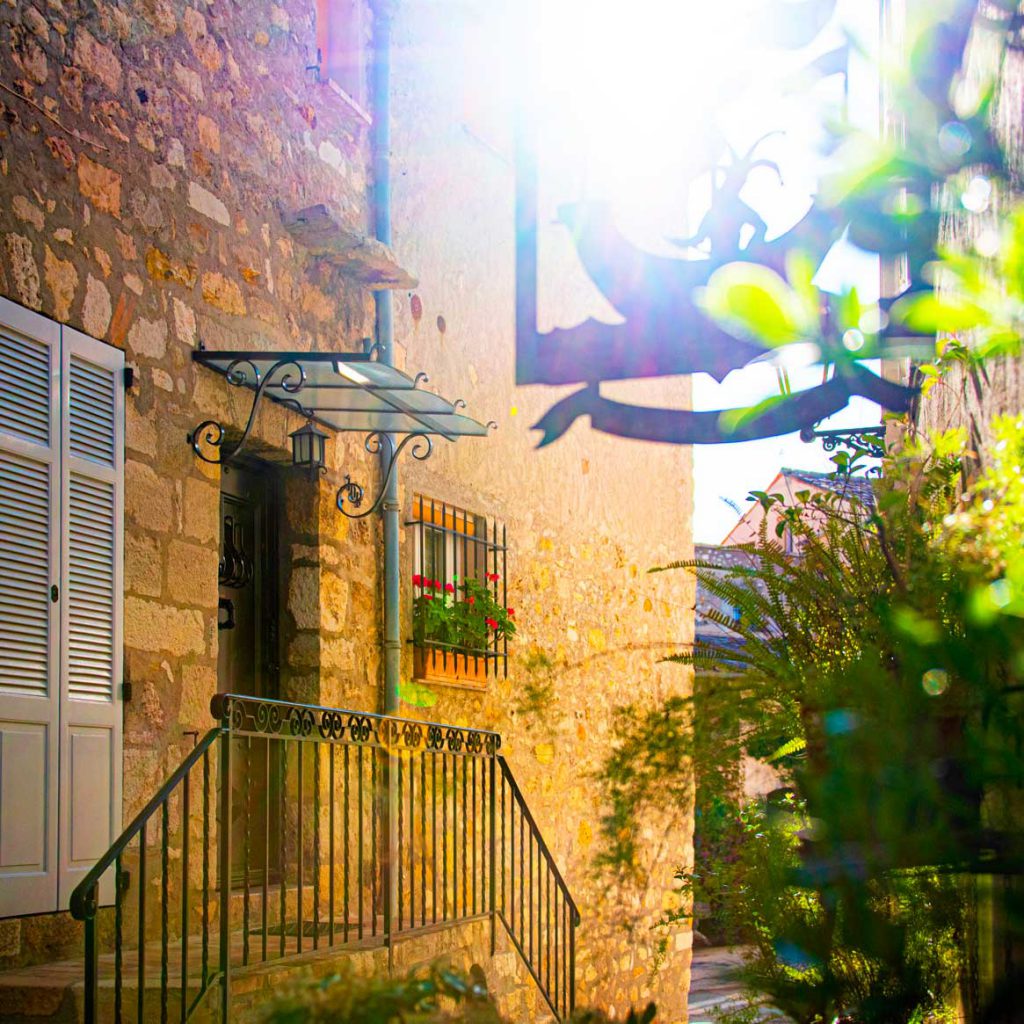Walk in the heart of the old village
Walk in the heart of the old village
Place du Commandant Lamy
From the Lavoir, head for the fountain that has stood at the intersection of Victoire and Commandant Lamy avenues since 1894. On your left, you will notice the restaurant “Au Rendez-vous de Mougins”, a former Hotel de France with a vaulted room on the first floor which was used as a court in the 15th century, in accordance with the Charter of 1438 stipulating that the Mouginois would be judges in their commune.
Opposite, the premises of the former post office, built over the cistern and outbuildings of an oil mill, adjoin the restaurant “Le Bistrot”.
Read more
A few years ago, this place was used as a stable and was home to the horses that participated in the life of the old mill in the impasse du Valat. The last olives were pressed here in 1918 and the mill was transformed into a house. Christian Dior was one of its illustrious occupants.
At the end of the square, you can see the old Town Hall, built in 1954 on the former Saint Bernardin Chapel of the White Penitents, built in 1618.
Heading towards rue du Badier, you will notice the façade of n°41 decorated by the Master Paul Daemen, a talented painter and portraitist who lived his last years in Mougins.
Rue du Badier
Henri de Badier was Treasurer General of the Generality of Provence. This alleyway “outside the walls” originates under the Saint-Bernardin Chapel (formerly the Town Hall) and ends at the covered passageway of the former Saint-Jacques Hospital. There was a flour mill as well as an oil mill known as the “blood mill” opposite one of the last bread ovens in the village. At the corner of this street and that of the Migraniers, is the house of Maurice Gottlob, who was a country warden and above all a well-known painter in our region. He had set up an art ceramics factory here. Translated with www.DeepL.com/Translator (free version)
Read more
Take the passageway and you will come to Rue Maréchal Foch. On your right, at number 78, is a statue of Saint-Jacques-le-Majeur in the wall of the old hospital, adjoining the residence of General Catroux. The wall will take you to the Place du lieutenant Isnard.
Place du lieutenant Isnard
Formerly known as the Place des Peyroues, it was the place where the stills were set up to distil the “aîgue Ardent”. One of the two fountains of the village and a watering place for the horses were located on this square. At number 26, magnificent paintings dating from 1510 were recently discovered (frescoes representing the white penitents). On your right, the rue de la glissade. Let yourself be tempted…
Rue de la Glissade
It is the old passage from Mougins to Le Cannet, Antibes, Valbonne and Vallauris. The Mouginois had given it the name of “Roumpe Cuou” because of its very steep slope. Under the covered passage, you can see an old press screw from an oil mill (now rue des Vanniers). Turn left into Rue des Isnardons, which borders on its western side the hotel “le Vaste Horizon”, which once welcomed Picasso and other artists on holiday in Mougins. Translated with www.DeepL.com/Translator (free version)
Vaste Horizon hotel
It was in this old hotel that, one fine morning in 1936, Picasso left his suitcases and fell in love with Mougins. He brought Paul Eluard, Jean Cocteau, Man Ray and Rosemonde Gérard with him and together they worked out a future full of new modes of expression in front of the beauty of the Lérins islands. The story goes that one night when the genius took hold of him, Picasso painted the entire walls of his room. Unfortunately, the artist was unknown and the hotel owner was very unhappy and forced him to repair the outrage.
Read more
A few pots of white paint did the trick. This did not discourage Picasso who settled permanently in Mougins, near the Chapelle Notre-Dame-de-Vie where he ended his days. Continue your visit by walking up towards the village towards the Place des Patriotes. At the fountain, turn left into rue Commandeur.
Rue Commandeur
This street was laid out in the glacis that surrounded the Village. Here you can admire an art studio before reaching the Place du Lieutenant Isnard again. From this square, you used to enter the town via the Sarrazine Gate and the Isnard Gate. The latter, demolished in the 18th century, was located at the top of the present Rue du Colonel Roustan.
Rue du Colonel Roustan
In the Middle Ages, it was the end of the road coming from Grasse and passing by the old fountain. It was named after “Colonel Roustan”, a Mougin hero who lived in the villa “Santa Lucia”. This residence also housed Roland Petit, Zizi Jeanmaire, Yves Saint Laurent, Paul Anka… On the way up, you walk along the remains of the old rampart and the covered way, to arrive at Place des Mûriers.
Place des Mûriers
The house where Commandant Lamy was born (n°36), the old tower was home to a barber-weaver who had the formidable honour of shaving, among others, the big-hearted bandit Gaspard de Besse, whom we find in Maurin des Maures and who was beaten in Aix-en-Provence in front of the weeping population. Nearby, an artist’s studio has opened its doors. The Place des Mûriers, formerly Place Saint-Pierre, was surrounded by ramparts. On the right, the rue du Moulin with the old oil mill known as “Moulin Isnard” transformed into a restaurant thanks to the master chef Roger VERGE.
Read more
This ruined mill had been restored by the fashion designer Roger Vivier who designed the Queen of England’s shoes for her coronation. In the dead end, the sheds, the cistern and the wine cellars of “La Salle”, the former abbey house of the abbots of Lérins, Lords of Mougins. At the end of the square, the old oven known as “Béranger’s oven” where the inhabitants were required to bake their bread.
The Sarrazine Gate
Place de l’Eglise Albicocco
It was an old cemetery, inside the walls. It was then transferred to Place Sainte-Anne and dug out to build a water reservoir in the basement, which was fed by a “fire pump”, which sent the water from the Horts de la Salle spring (Mougins’ first water supply) back to Mougins. On the right, the Presbytery rebuilt before the revolution on the site of a cesspool and a former “blood mill”. Opposite, an old defence tower that stood against the ramparts. You can spend some time in the church of Saint-Jacques-le-Majeur.
Read more
The oldest part of the church, which you can see with the door of the present sacristy surmounted by a stone cross, was probably the former lordly chapel of St Mary. The church was built in three stages, starting in the 11th century with the name of St. James the Greater. A second nave was added at the beginning of the 19th century and renovated.
The parish church of Saint-Jacques-le-Majeur
The sacristy dates from the 11th century. The church was enlarged in the 18th and 19th centuries, as was the bell tower which was raised. There are statues of Saint Joseph and Saint Mary in gilded cardboard from the Grasse School of the 18th century, and a 15th century crucifix. The stoup and the baptismal font are from the 18th century. In the choir, the altar stone was carved in the 11th century. Outside the church, go back a few steps and enter Rue des Lombards.
Rue des Orfèvres
It was an alleyway backing onto the ramparts inside the village. There were many craftsmen and notably a goldsmith, Bernardin Bareste. In 1666, he was certainly the only goldsmith in the region and he beat the gold coins of the Abbey of Lérins. Today, you will still find many craftsmen.
Rue des Lombards
On your right you can see the entrance and the main courtyard of the Abbey House of the Abbots of Lérins. At n°71 Jacques Brel is said to have stayed there while he was taking his pilot’s licence. Finally, take rue Honoré Henry which will bring you back to the starting point.
Rue Honoré Henry
It was named after Honoré Henry, former Mayor of Mougins. After reaching the Place du Commandant Lamy, head towards the Place des Patriotes.
Place des Patriotes
The Lavoir, built in 1894, was used by tenacious washerwomen until the 1970s. It hosts exhibitions all year round and a Provencal cot in December. Opposite, the Boutique du Maréchal Ferrant and the former municipal slaughterhouses on the ramparts have been transformed into an art gallery and bar, whose vaulted room is worth a visit. The square itself was built on the former cemetery of Sainte-Anne. The chapel of the same name, which stood opposite the restaurant “L’Amandier”, has unfortunately been destroyed.
Read more
From the viewpoint indicator near the statue of Commandant Lamy, the famous son of Mougins who gave his name to the capital of Chad, “Fort Lamy”, now “N’djamena”, you can admire the view that extends from the Esterel over the Pays de Grasse and the Mercantour mountain range to the Bay of Cannes.
This is where the walk on the rocky outcrop ends; we hope it has allowed you to relive a little of Mougins’ past.
For more anecdotes and information, don’t hesitate to choose a guided tour in the company of our trip advisor… Tap here















